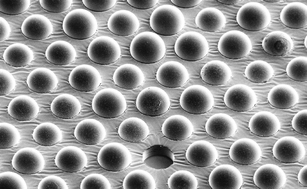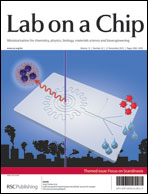Capture, isolation and release of cancer cells with aptamer-functionalized glass bead array†
Abstract
Early detection and isolation of circulating tumor cells (CTC) can enable better prognosis for cancer patients. A Hele-Shaw device with aptamer functionalized glass beads is designed, modeled, and fabricated to efficiently isolate cancer cells from a cellular mixture. The glass beads are functionalized with anti-epidermal growth factor receptor (EGFR) aptamer and sit in ordered array of pits in polydimethylsiloxane (PDMS) channel. A PDMS encapsulation is then used to cover the channel and to flow through cell solution. The beads capture cancer cells from flowing solution depicting high selectivity. The cell-bound glass beads are then re-suspended from the device surface followed by the release of 92% cells from glass beads using combination of soft shaking and anti-sense RNA. This approach ensures that the cells remain in native state and undisturbed during capture, isolation and


 Please wait while we load your content...
Please wait while we load your content...